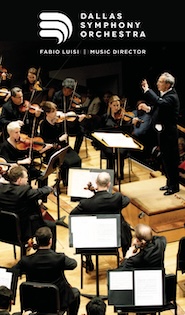DiDonato returns to Houston with “In War and Peace”
Joyce DiDonato brought her career full circle Wednesday night when she stepped onstage at the Wortham Theater Center’s Cullen Theater–the same hall where, in 1996, she vied in the Houston Grand Opera’s young artist competition.
The budding mezzo-soprano was awarded third place, but the HGO Studio still took her in and DiDonato would go on to win international acclaim.
HGO brought her back Wednesday in a touring concert production that DiDonato premiered in 2016 titled “In War & Peace: Harmony Through Music.”
Combining staging, costumes, lighting, video projections, an orchestra—with the period-instrument group Il Pomo d’Oro, woven into the staging—the program was built around 17th- and 18th-century arias, as a kind of pastiche baroque opera with DiDonato at its center. Though it lacked a plot as such, it still had an emotional trajectory, from agitation and heartbreak to healing and celebration.
DiDonato’s electricity and expressiveness, both vocal and visual, galvanized all that Wednesday. Because she sat motionless at the rear of the stage from the moment the ushers opened the theater, at least 20 minutes separated DiDonato’s warmups from the opening number: “Scenes of horror, scenes of woe” from Handel’s Jeptha.
But she nevertheless came out blazing. Handel’s jagged, leaping vocal lines held no fears for her. DiDonato hurled them out with abandon–her voice vibrant and focused at the top, lusty and booming when it plunged. She bit fiercely into words, making the sharpness of her diction and the edge of her tone redouble the music’s violence.
Her singing was even more visceral in “Prendi quel ferro, o barbaro!” from Leonardo Leo’s Andromaca. DiDonato relished the aria’s mood swings. In the outbursts, her singing was even more intense than before, and she surged through flourishes that spanned her voice’s entire range. When the music suddenly turned inward, DiDonato sang in half-shades that made the introspections as arresting as the fireworks.
Guided, presumably, by stage director director Ralf Pleger, DiDonato cut a commanding figure all the while. She began “Scenes of horror” as if recoiling from the spectacle before her–her eyes blocked by her hands, fingers splayed. In “Prendi il ferro,” her hand sometimes jabbed at the air as if she brandished a sword. The clashing colors of the makeup splashed across DiDonato’s face and chest added yet another violent note.
Through sheer vocal contrast, DiDonato set off dynamite at the start of “Pensieri, voi me tormentate” from Handel’s Agrippina. The aria describes thoughts tormenting Agrippina, and Donato whispered its first phrase in tones that were vibratoless and almost drained of color. Then her voice welled up in an outcry, revealing Agrippina’s turmoil.
A billowing, free-form but regal gown by Vivienne Westwood helped turn DiDonato into the heroine of Henry Purcell’s Dido and Aeneas. DiDonato’s singing took over from there, as “When I am laid in earth” unfolded in long-breathed line that exuded Dido’s self-sacrificing nobility; the pianissimo of Dido’s final admonition to “Remember me” was all the more poignant.
DiDonato treated the program’s other well-known aria, “Lascia ch’io pianga from Handel’s Rinaldo, to yet more long-lined, subtly shaded singing.
That closed the performance’s first half, devoted to war. After intermission, peace took over, and the harsh makeup on DiDonato’s face and chest gave way to lighter, more graceful shapes.
“They tell us that you mighty powers” from Purcell’s Orazia unfolds with a simple tunefulness that harkens back to English lute songs, and DiDonato complemented that by tracing its melody in gentle, light strokes. She brought richer tones to the sunny lyricism of “Crystal streams in murmurs flowing” from Handel’s Susanna.
Then vocal virtuosity returned.
DiDonato’s agility and crispness let her bring out the charm in the avian tone-painting of “Augeletti, che cantate” from Handel’s Rinaldo; flutist Anna Fusek stepped out of the orchestra to interact, lending a breezy touch to the extensive, warbling solos. Then DiDonato swept through the roulades of the finale, “Dopo notte” from Handel’s Ariodante, with full-throated exuberance and a smiling demeanor.
Conductor Maxim Emelyanychev and the chamber orchestra complemented DiDonato’s vividness with their own vigor and transparency. They also savored the expressiveness of the tangy harmonies and telling lyricism in their interludes, from Purcell’s Chaconne in G minor and Carlo Gesualdo’s Tristis est anima mea to the more-recent but complementary Da pacem, Domine by Arvo Pärt.
Alongside all this, In War & Peace’s larger theatrical trappings unfolded vividly. But they revealed little beyond what DiDonato, the orchestra and the music so richly portrayed in the singing and playing.
Yousef Iskandar’s abstract video projections generally suited the music’s tone, from the swirling shards and tangled contours that accompanied the most agitated arias to the rippling blue expanses during Handel’s “Crystal streams.” The red glow that bathed Dido’s lament was a puzzle, though. Did it suggest that she was designed for hell?
From In War & Peace’s first moments, DiDonato shared the stage with dancer-choreographer Manuel Palazzo. Occasionally his role was clear–as when he gripped DiDonato from behind in Agrippina’s aria, which discusses her son. But most of the time, Palazzo’s presence seemed more decorative than dramatic.
The music ultimately had the last word. DiDonato’s first encore, “Par che di giubilo” from Niccolò Jommelli’s Attilio Regolo, brought yet another burst of exultant gymnastics. Palazzo’s swirling sweeps across the stage added their own acrobatic flourish.
Picking up a microphone to speak, DiDonato reminisced about that long-ago HGO contest, then discussed the global violence that led her to spearhead “In War & Peace.” Finally, citing a spirit of hopefulness, she switched musical eras and sang “Morgen,” Richard Strauss’ meditation on tomorrow. Her spaciousness and half-tones suited Strauss as well as they had Purcell and Handel.
